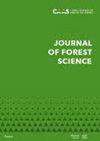Silvicultural options to promote natural regeneration of Scots pine (Pinus sylvestris L.) in Western Ukrainian forests
IF 1.1
Q3 FORESTRY
引用次数: 1
Abstract
Scots pine (Pinus sylvestris L.) forests belong to the most relevant forest types in the Western Ukrainian Roztochia area. The promotion of close-to-nature forest management in Ukraine in the framework of the forest strategy 2 035 supports natural regeneration and the application of diverse felling methods beyond clearcutting. In the present study, natural regeneration was analysed in mixed Scots pine stands on poor and relatively rich soils, after small clearcuts, shelterwood cutting and gap fellings (with or without soil preparation), with respect to tree species composition, species abundance and height growth. It could be shown that Scots pine is the most abundant species in all the felling systems, with on average more than 100 000 plants per ha on poor soils. Other admixed tree species only occur with small shares. Natural regeneration, especially of Scots pine, was less abundant on rich soils and in shelterwood, compared to a small clearcut. After the young plants have established, their abundance declined in the second and third year due to competing herbaceous plants and thick litter.促进乌克兰西部森林苏格兰松(Pinus sylvestris L.)自然再生的造林选择
苏格兰松(Pinus sylvestris L.)森林属于乌克兰西部Roztochia地区最相关的森林类型。在《2035年森林战略》的框架内促进乌克兰接近自然的森林管理,支持自然再生和采用除砍伐森林以外的各种采伐方法。在本研究中,我们分析了在贫瘠和相对肥沃的土壤上的混合苏格兰松林,经过小范围的砍伐、防护林砍伐和林隙砍伐(有或没有土壤准备)后,树种组成、物种丰度和高度生长的自然更新情况。结果表明,在所有采伐系统中,苏格兰松是最丰富的物种,在贫瘠的土壤中,平均每公顷有超过10万株。其他杂交树种仅以小份额出现。自然再生,尤其是苏格兰松,在肥沃的土壤和防护林中,与一小块干净的森林相比,再生较少。幼苗建立后,第二年和第三年由于草本植物的竞争和厚厚的凋落物,它们的丰度下降。
本文章由计算机程序翻译,如有差异,请以英文原文为准。
求助全文
约1分钟内获得全文
求助全文
来源期刊

Journal of forest science
Forestry-
CiteScore
2.30
自引率
9.10%
发文量
48
审稿时长
6 weeks
期刊介绍:
Original results of basic and applied research from all fields of forestry related to European forest ecosystems and their functions including those in the landscape and wood production chain are published in original scientific papers, short communications and review articles. Papers are published in English
 求助内容:
求助内容: 应助结果提醒方式:
应助结果提醒方式:


